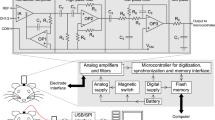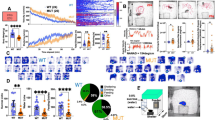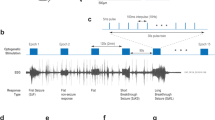Abstract
Epilepsy is a debilitating disease characterized by recurring seizures. Epilepsy can be studied using animal models, such as rodents prone to audiogenic seizure (AGS), which experience generalized seizures (loss of consciousness accompanied by rhythmic muscle spasms and rigid muscle stiffness) after intense sound stimulation. In 1933, a spontaneous mutation resulting in sensitivity to AGS was observed among laboratory stocks of deer mice (Peromyscus maniculatus artemisiae) at the University of Michigan. Since then, AGS-sensitive deer mice have been maintained as a separate stock, currently housed at the Peromyscus Genetic Stock Center. To further characterize AGS, the authors designed reliable and consistent equipment for inducing and monitoring AGS in deer mice.
This is a preview of subscription content, access via your institution
Access options
Subscribe to this journal
We are sorry, but there is no personal subscription option available for your country.
Buy this article
- Purchase on Springer Link
- Instant access to full article PDF
Prices may be subject to local taxes which are calculated during checkout




Similar content being viewed by others
References
Prasad, A.N., Prasad, C. & Stafstrom, C.E. Recent advances in the genetics of epilepsy: insights from human and animal studies. Epilepsia 40, 1329–1352 (1999).
Noebels, J.L. Single-gene models of epilepsy. Adv. Neurol. 79, 227–238 (1999).
Ross, K.C. & Coleman, J.R. Developmental and genetic audiogenic seizure models: behavior and biological substrates. Neurosci. Biobehav. Rev. 24, 639–653 (2000).
Misawa, H. et al. Identification of a monogenic locus (jams1) causing juvenile audiogenic seizures in mice. J. Neurosci. 22, 10088–10093 (2002).
Neumann, P.E. & Collins, R.L. Genetic dissection of susceptibility to audiogenic seizures in inbred mice. Proc. Natl. Acad. Sci. USA 88, 5408–5412 (1991).
Banko, M.L., Allen, K.M., Dolina, S., Neumann, P.E. & Seyfried, T.N. Genomic imprinting and audiogenic seizures in mice. Behav. Genet. 27, 465–475 (1997).
Skradski, S.L. et al. A novel gene causing a mendelian audiogenic mouse epilepsy. Neuron 31, 537–544 (2001).
Dice, L.R. Inheritance of waltzing and of epilepsy in mice of the genus Peromyscus. J. Mammal. 16, 25–35 (1935).
Watson, M.L. The inheritance of epilepsy and of waltzing in Peromyscus. Contrib. Lab. Vert. Gen. Univ. Michigan No. 11 (1939).
Finger, F.W. Convulsive behavior in the rat. Psych. Bull. 44, 201–248 (1947).
Hall, C.S. Genetic differences in fatal audiogenic seizures between two inbred strains of house mice. J. Hered. 38, 2–6 (1947).
Chance, M.R.A. & Yaxley, D.C. New aspects of the behaviour of Peromyscus under audiogenic hyper-excitement. Behaviour 2, 96–105 (1949).
Lander, E.S. & Botstein, D. Homozygosity mapping: a way to map human recessive traits with the DNA of inbred children. Science 236, 1567–1570 (1987).
Barto, E. Tests for independence of Waltzer and EP sonogenic convulsive from certain other genes in the deermouse (Peromyscus maniculatus). Contrib. Lab. Vert. Biol. Univ. Michigan No. 74 (1956).
Comparative Examples of Noise Levels (Industrial Noise Control, Inc., North Aurora, IL, 2000). http://www.industrialnoisecontrol.com/comparative-noise-examples.htm.
Joyner, C.P., Myrick, L.C., Crossland, J.P. & Dawson, W.D. Deer mice as laboratory mice. ILAR J. 39, 322–330 (1998).
Crossland, J.P. & Lewandowski, A. Peromyscus—a fascinating laboratory animal model. TechTalk 11 (2006).
Author information
Authors and Affiliations
Corresponding author
Ethics declarations
Competing interests
The authors declare no competing financial interests.
Rights and permissions
About this article
Cite this article
Veres, M., Payne, S., Fernandes, P. et al. Improved technique for induction and monitoring of audiogenic seizure in deer mice. Lab Anim 42, 166–169 (2013). https://doi.org/10.1038/laban.263
Received:
Accepted:
Published:
Issue Date:
DOI: https://doi.org/10.1038/laban.263



